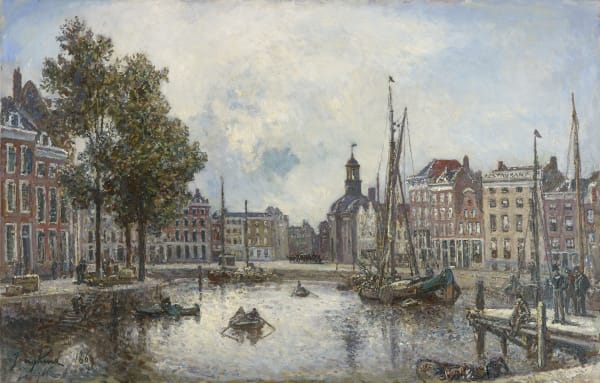Armand Guillaumin French, 1841-1927
The renowned French artist Armand Guillaumin was a long-standing member of the Impressionist group, celebrated for his bold landscapes of the Parisian suburbs and the South of France.
Born in Paris in 1841, Guillaumin was sent away to school in Moulins, a small village in rural France - where he began drawing classes at a young age. The verdant, mountainous landscape surrounding Moulins would leave a lasting impression on the young artist. In 1854, Guillaimin moved back to Paris to enroll at the Académie Suisse where he befriended Paul Cézanne and Camille Pissarro.
At the beginning of his career, Guillaumin’s painting was influenced by the 19th Century Realist movement, demonstrating refined brushwork and a more naturalist palette reminiscent of Gustave Courbet.
He became known as a member of the Impressionist group through exhibiting at the Salon des Refusés in 1863 alongside works by both Cézanne and Pissaro. During this time, Guillaumin was an active member of the avant-garde which coalesced around Édouard Manet at the Café Guerbois, laying the foundations on which the Impressionist movement was built.
Unlike several other Impressionist painters, Guillaumin had a parallel occupation which funded his artistic career. Much of his characteristic style was developed by painting en plein-air in the outskirts of Paris while employed by the Paris-Orléans railway - often depicting quotidian scenes such as men labouring and barges along the banks of the Seine.
In the early 1870s, Guillaumin repeatedly painted the north-western suburbs of Paris with Pissarro at Pontoise, and both Cézanne and Dr Gachet at Auvers where Daubigny lived and worked. Guillaumin's mature Impressionist style was developed during this period - the group’s aesthetic approach influenced the strong pictorial composition and shimmering sense of light achieved in Guillamin’s works from this period. Both his expressive use of contrasting colour, and gestural brushwork suggests a transcendental view of nature refracted into vibrant harmonies.
Guillaumin contributed to all but two of the Impressionist exhibitions, showing in 1874, 1877, 1880, 1881, 1882 and 1886. In 1891, the artist won 100,000 francs in the lottery, enabling him to pursue his artistic research with more freedom and autonomy from collector interest.
The works produced by Guillaumin in the late 1890s would go on to considerably influence the forthcoming Post-Impressionist artists. His evolving technique, from the early realistic period to his Impressionist approach, placed him as a key figure in the development of the early 20th century painting.
Armand Guillaumin’s work is included in numerous collections around the world, such as Musée d'Orsay, Paris ; Tate Britain, London ; Metropolitan Museum, New York; Montréal Museum of Fine Arts ; Thyssen-Bornemisza Museum, Madrid.
-

TEFAF Maastricht 2023
11 - 19 Mar 2023Join us at TEFAF Maastricht 2023, where we are exhibiting a selection of 19th and 20th-century French paintings and works on paper, including works by Eugène Boudin, Gustave Courbet, Charles-François...Read more -

Rhythm of lines and colours in French Avant-Garde
28 Jun - 26 Jul 2019Stoppenbach & Delestre is pleased to present 'Rhythm of lines and colours in French Avant-Garde', an exhibition including works by Charles-François Daubigny, Eugène Boudin, Armand Guillaumin, Hippolyte Petitjean, Louis Valtat,...Read more -

TEFAF Maastricht 2019
16 - 24 Mar 2019For TEFAF Maastricht 2019, Stoppenbach & Delestre is pleased to present a selection of 19th & 20th-century French artworks such as works by Louis Valtat, Henry Moret, Gustave Loiseau, Armand...Read more -

TEFAF New York Fall 2018 - Booth 321
25 - 31 Oct 2018Stoppenbach & Delestre is pleased to announce its participation in TEFAF New York Fall 2018. Featuring works by André Derain, Charles-François Daubigny, Maximilien Luce, Jean-Baptiste Camille Corot, Armand Guillaumin and...Read more






